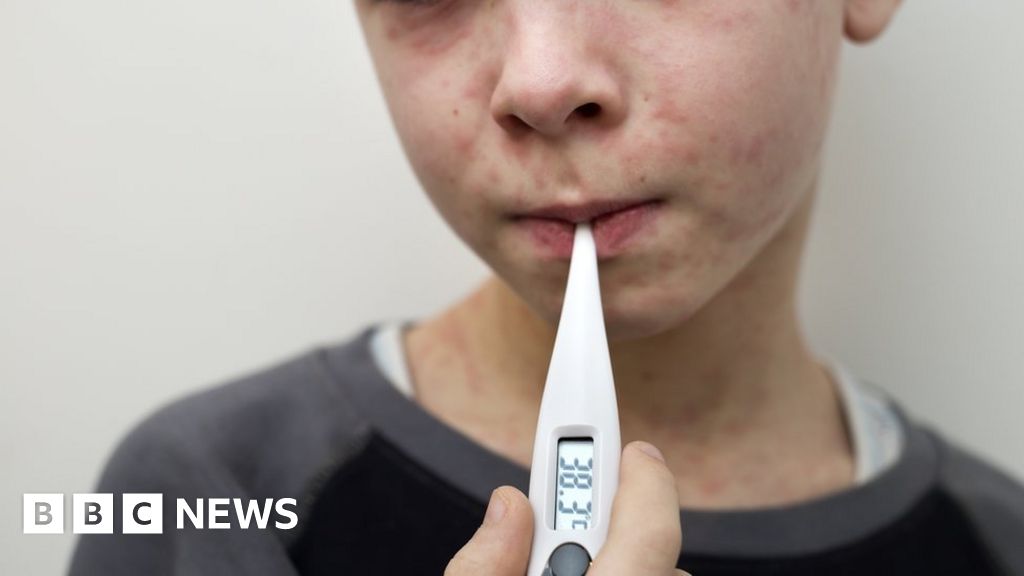Image source, Getty Images
Measles cases are likely to spread rapidly unless more people are vaccinated, the UK Health Security Agency has warned.
Pop up clinics are being introduced to get more children vaccinated, after figures showed uptake at the lowest level for more than a decade.
What is measles?
Measles is a highly contagious disease which is spread by coughs and sneezes.
It normally clears up after seven to 10 days.
However, it can lead to serious problems if it infects other parts of the body, such as the lungs or brain.
Complications can include pneumonia, meningitis, blindness, and seizures.
Babies and young children, pregnant women and those with a weakened immune system are more at risk.
Measles can be fatal, but this is rare.
Why are measles cases rising and where are there outbreaks?
More than 200 cases have been confirmed in the West Midlands in recent months, mostly in Birmingham.
There have also been dozens of cases reported in London, where nearly half of children have not been vaccinated.
There were 1,603 suspected cases of measles in England and Wales in 2023, according to the UK Health Security Agency (UKHSA).
That is up sharply from 735 cases in 2022 and 360 in 2021.
Measles vaccinations were introduced in the UK in 1968 and are thought to have prevented 20 million measles cases and 4,500 deaths.
The current two-dose MMR jab was first used in 1996, but false concerns over the link with autism caused vaccination rates to drop.
NHS figures show that in 2022-23, 84.5% of children had received two MMR doses by the time they were five years old, the lowest level since 2010-11, when Mr Wakefield was struck off.
What are measles symptoms and what is the rash?
- high fever
- sore, red and watery eyes
- coughing
- sneezing
- feeling generally unwell
Small white spots may appear inside the mouth.
A blotchy red or brown rash usually appears a few days after the initial symptoms, typically on the face and behind the ears before spreading to the rest of the body.
It can be harder to see on brown and black skin.
Image source, Getty Images
How is measles spread?
The virus is contained in tiny droplets which are released when an infected person coughs or sneezes.
You catch measles by breathing in the droplets, or touching them and placing your hand near your nose or mouth.
People with measles are infectious until at least four days after the rash appears.
Those with mild symptoms are asked not to visit their GP or hospital but to call the NHS on 111 or get help online.
They should also stay away from nursery, school, university, work and other group activities while they are infectious.
What should you do if you get measles?
The NHS advises patients to:
- take paracetamol or ibuprofen to relieve fever, aches and pains – aspirin should not be given to children under 16 years old
- rest and drink plenty of fluids
- wash their hands regularly with soap, and clean their eyes with damp cotton wool
- put used tissues and cotton wool in the bin
You should go to A&E or phone 999 if you or your child:
- have shortness of breath
- have a high temperature that does not come down with paracetamol or ibuprofen
- are coughing up blood
- feel drowsy or confused
- have fits (convulsions)
Pregnant women or those with a weakened immune system should seek urgent medical advice after contact with someone with measles.
Who can have the MMR vaccine?
The first MMR dose is given at 12 months, and the second at about three years and four months, before children start school.
Image source, Getty Images
However, adults and children can have the jab at any age.
Those who do not eat pork products can request an alternative version called Priorix from their GP.
If the MMR vaccine is not suitable, a treatment called human normal immunoglobulin (HNIG) can be given to someone who is at immediate risk of catching measles.
What are the side effects of the MMR jab?
Most side effects are mild and do not last long.
The area where the needle goes in can be red, sore and swollen for a few days.
Babies and young children may develop a high temperature for up to 72 hours.
Researcher Andrew Wakefield wrongly claimed the two were connected in 1998.
Please include a contact number if you are willing to speak to a BBC journalist. You can also get in touch in the following ways:
If you are reading this page and can’t see the form you will need to visit the mobile version of the BBC website to submit your question or comment or you can email us at HaveYourSay@bbc.co.uk. Please include your name, age and location with any submission.
